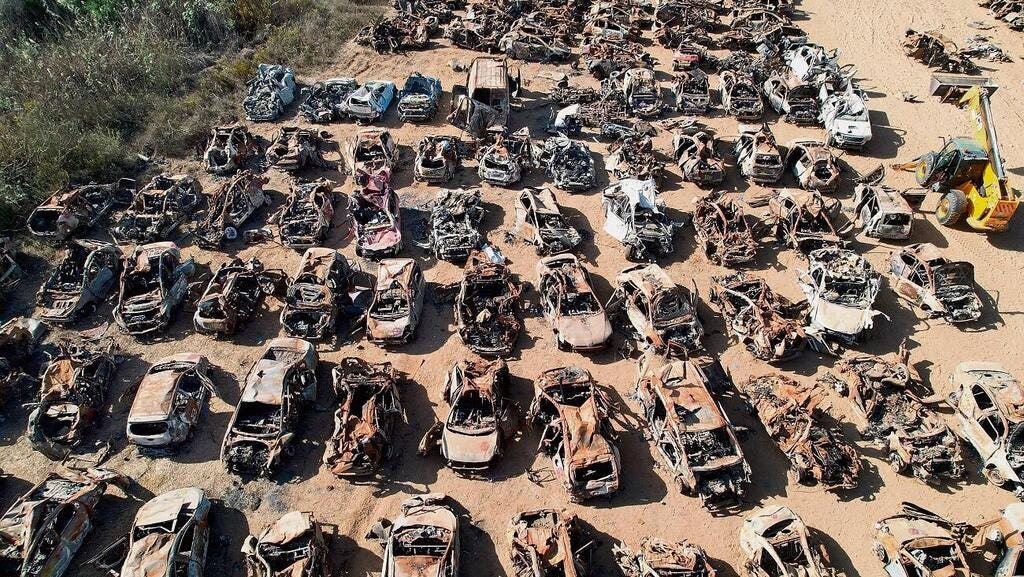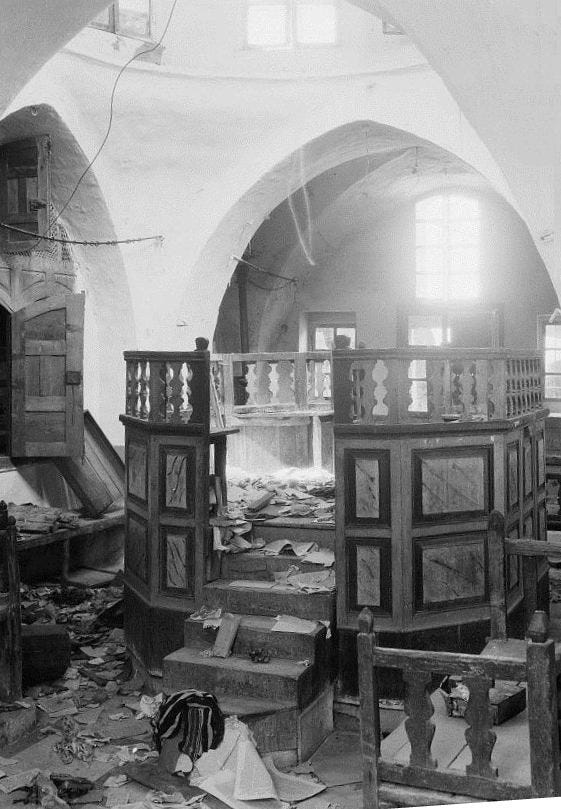The Massacre That Ignited the Israeli-Palestinian Conflict
The images and testimonies that emerged from Hamas’ October 7th attacks bear a chilling resemblance to the massacre of one of the world’s most ancient Jewish communities in 1929.

Please consider supporting our mission to help everyone better understand and become smarter about the Jewish world. A gift of any amount helps keep our platform free of advertising and accessible to all.
This is a guest essay written by Yardena Schwartz, an award-winning journalist and the author of “Ghosts of a Holy War.”
You can also listen to the podcast version of this essay on Apple Podcasts, YouTube Music, YouTube, and Spotify.
When I awoke in New York on October 7th, 2023, I thought I had stepped into the dark pages of history I had spent the last four years researching.
At the time, I was writing a book about a massacre that took place one century ago in the British Mandate of Palestine. The images and testimonies that emerged from Hamas’ attack bore a chilling resemblance to the massacre of one of the world’s most ancient Jewish communities on August 24th, 1929.
In debates about the context of the war in Gaza, dates like 1948 and 1967 are often discussed, as if this war began with the establishment of the State of Israel, or the Six-Day War, respectively. Yet the history that is necessary to truly understand this war begins before the State of Israel was born.
Ninety-five years ago, 3,000 Muslim men marched through the Jewish Quarter of Hebron: burial place of Abraham, forefather of the Jewish and Arab nations. Enflamed by a campaign of disinformation launched by the British-appointed Grand Mufti of Jerusalem, the mob went from house to house, stabbing, torturing, raping, and in some cases castrating and burning their Jewish neighbors. Over the course of two hours that morning, nearly 70 unarmed Jewish men, women and children were slaughtered.
“The horror of it is beyond words,” wrote John Chancellor, the British High Commissioner of Palestine, in his diary on October 8th, 1929, after visiting Hebron, where the walls and floors of Jewish homes were still stained with blood. “I do not think history records many worse horrors in the last few hundred years.”

In 1929, there was no “Israeli occupation” of Palestinian land. The Holocaust had not yet vanquished over a third of the world’s Jewish population and driven hundreds of thousands of European Jews to their ancient homeland. Palestine was under British rule, which had replaced five centuries of Ottoman rule, which had followed a long list of other foreign powers. Jews and Arabs living in the land between the Jordan River and the Mediterranean Sea were all Palestinians living under foreign occupation.
The forces that drove Arabs in Hebron to slaughter their Jewish neighbors mirror the forces behind October 7th. To rally the Arabs of Palestine behind him, and to propel his standing in the wider Muslim world, the leader of Palestinian Muslims under British rule waged a campaign of fear and religious passion. Beginning in 1928, the Grand Mufti of Jerusalem, Haj Amin Al-Husseini, claimed that the Jews of Palestine were plotting to conquer Al-Aqsa Mosque to rebuild their ancient Temple.
If that sounds familiar, it should. Hamas named its operation on October 7th the “Al-Aqsa Flood.” Both before the attack and since, Hamas leaders have framed their motive as the liberation of Al-Aqsa, which sits atop the ruins of the ancient Jewish temples in Jerusalem. Known to Jews as the Temple Mount, it is the centerpiece of the Jewish faith, the holiest site in Judaism. In 1929, it was under Muslim rule, and Jews were forbidden from ascending to the mount. Today, it is under Israeli rule.
While Jews are permitted to visit at certain hours, they are forbidden from praying there. Thousands of Muslims pray there each day. Though Israel’s pyromaniacal National Security Minister, Itamar Ben-Gvir, seeks to upend that status quo by permitting Jewish prayer there, Israel has no intention of destroying Al-Aqsa or building the Third Temple.
The Wailing Wall, the last remnant of the Second Temple, is the holiest place where Jews are permitted to pray. On August 14th, 1929, the eve of Tisha B’Av, the most mournful day on the Hebrew calendar, thousands of Jews gathered at the wall to seek divine forgiveness and pray for redemption. British troops surrounded the Jewish worshippers to protect them.
Leading up to that evening, the Grand Mufti had initiated a construction project at the wall, where stones often fell upon Jewish worshippers. He also added a door to the wall, allowing Muslims to ascend to Al-Aqsa, and leading to many incidents in which Jews were assaulted while praying. The British ignored complaints from the Jewish community until Tisha B’Av, where troops finally protected Jewish worshippers.
The following day, hundreds of Jews marched to the wall, calling for the British to grant them ownership of it: “The wall is ours,” they chanted, waving flags bearing the Star of David and singing what became Israel’s national anthem, Hatikvah — “The Hope” — an ode to the 2,000-year-old longing for Jerusalem.
The march was precisely what the Grand Mufti needed to rally the Muslims of Palestine behind him. Husseini had long faced criticism from his political opponents and segments of the Arabic press, with accusations of corruption, misappropriated funds and nepotism. Rumors quickly spread that the Jewish youth who marched to the Western Wall on August 15th had attacked Muslim residents, cursed the Prophet Muhammad, and raped Muslim women.
None of this was true.
Though the demonstration was provocative, it had been peaceful, and directed at the British authorities. Nevertheless, pro-mufti activists spread those rumors and called for revenge.
In sermons at Al-Aqsa one week later, clerics called on the faithful to defend Islam with their blood. Armed worshippers flowed from the mosque and down to the Old City, where they attacked Jewish pedestrians and set fire to Jewish businesses. The riots quickly spread throughout Palestine, killing 133 Jews, and wounding 400 more. The Jews of Hebron paid the heaviest price, suffering more brutality and more casualties than any other community in Palestine.
Just as the mufti claimed that the Jews of Palestine were planning to destroy Al-Aqsa, Hamas perpetuates that same claim today, following the formula set by the Grand Mufti and followed by every Palestinian leader since. Since its establishment in 1987, Hamas has worked to silence or kill Palestinians it accuses of collaborating with Israel. Its leaders have succeeded in distracting Palestinians and their supporters from Hamas’ crimes against its own people.
The victims in Hebron in 1929 were not “settlers.” In fact, they were not even Zionists. The Jews of Hebron lived peacefully among 20,000 Muslims. A pious community of 800 people whose existence centered around Torah study, they lived in what was known as the ghetto, a maze of alleyways near the Tomb of the Patriarchs and Matriarchs, where Abraham and Sarah, Isaac, and Rebecca, and Jacob and Leah are believed to be buried. Jews had lived near this holy soil for nearly four thousand years.
Just as the Jews who were killed in Hebron in 1929 were not Zionists, the Jews who were murdered, maimed and kidnapped on October 7th were not settlers. Many were Left-wing Israelis who had spent the previous nine months protesting Benjamin Netanyahu’s far-Right government. Many of the victims were peace activists who worked to build bridges between Israelis and Palestinians and helping civilians in Gaza receive medical treatment in Israel.
According to numerous Palestinian polls, support for Hamas in Gaza and the West Bank soared in the wake of October 7th. The majority of Palestinians deny that Hamas murdered children, raped women, or killed any civilians. Palestinian officials and some on the far-Left have called these atrocities Israeli propaganda. In 1929, the perpetrators of the massacre in Hebron were also hailed as heroes. The horrors they committed were also denied.
The line between 1929 and 2023 cuts through a century of Muslim leaders’ refusal to share this homeland of the Abrahamic faiths with the Jewish people. The Grand Mufti rejected the first two-state solution, proposed by the British, in 1937. He did so again in 1947, when the United Nations voted to partition Palestine into one Arab state and one Jewish state. That partition plan led to a declaration of war by the mufti and surrounding Muslim states.
That war is known by most Jews as Israel’s War of Independence. It is known to Palestinians, and many Muslims, as “the Nakba” — when more than half of Palestine’s Arab population left the country in a mix of flight and expulsion. The Grand Mufti’s political descendants have rejected every two-state solution since.
The failure of British forces to protect the Jews of Palestine in 1929 led them to unite around what had until then been a divisive movement: Zionism, or, the quest for Jewish statehood. After the 1929 massacre, Jews who had opposed Zionism now agreed they could only be safe in their own country, under the protection of their own army. If the Grand Mufti had hoped to thwart the Zionist quest for Jewish self-determination, his actions only accelerated the very forces he sought to extinguish.
As we mark 95 years since the Hebron massacre, we have also reached another stark milestone: one year since Hamas’ attack launched the devastating war in Gaza. With tens of thousands dead and Gaza in ruins, Palestinians have gained nothing, and lost nearly everything. In Israel, thousands are still grieving over the horrors of October 7th as they await the return of 105 hostages, and nearly 100,000 remain displaced from their homes due to continued rocket fire from Hamas and Hezbollah.
The massacre of 1929 set the stage for the world’s most enduring conflict, only to be repeated on October 7th. In its aftermath, we have the benefit of knowing this history, and learning from it.
If we truly wish to honor the memory of all the lives lost to this war, and to prevent more senseless death and destruction, we must understand the roots of this century-long war, and the Islamist extremism and misinformation that have fueled it.





Fantastic article .. sadly too many ignorant and stupid fashionistas believe that a country called Palestine was taken by european colonialists .. even though the factual history, outlined in this excellent article will not provide a peaceful resolution. The Arab world has no real interest in the so called palestinians. They were expelled from Jordan in the 1970s. The UN, UNWRA, Western governments & NGOs perpetuation of refugee status serves 'no good' to the people.
The sad irony is that if Gaza had elected a moderate Arab political party in 2007 instead of Hamas, and then spent their development cash on social projects not military projects i.e. rockets and tunnels, they might have been given a state eventually. Not going to happen now. History as it might have been.